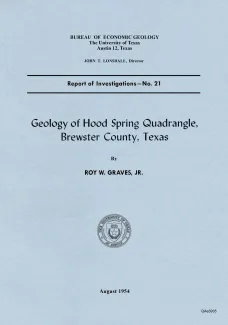
Publication Details
Geolocation:
Get the Publication
$22.50
Abstract/Description:
The Hood Spring quadrangle, in the central part of Brewster County, Texas, contains a segment of the southeast rim of the Marathon basin. It includes a part of the complexly folded and faulted Paleozoic rocks that occur in the center of the Marathon basin and also includes Cretaceous rocks exposed in the Maravillas scarp. This scarp has three stratigraphically separate cuestas that are formed by southeastward gently dipping beds. The southwestern corner of the quadrangle contains a faulted and folded segment of the Santiago Mountain range. Rocks of Cambrian (Dagger Flat formation), Ordovician (Marathon, Alsate, Fort Pena, Woods Hollow, and Maravillas formations), Devonian (Caballos novaculite), and Pennsylvanian (Tesnus formation)ages occur in the area of Paleozoic outcrops. A conodont fauna from the upper part of the Caballos novaculite indicates a Middle to Upper Devonian age for those beds. Most of the Cretaceous rocks exposed in the quadrangle belong to the Comanche series (Glen Rose, Maxon, Walnut-ComanchePeak, Edwards, Kiamichi, Georgetown, Grayson, and Buda formations) and are similar to equivalent age strata in central Texas. Gulf series rocks (Boquillas and Terlingua formations) have a restricted occurrence in the southwestern corner of the quadrangle contains a faulted and folded segment of the Santiago Mountain range. Tertiary intrusions include plugs, dikes, and sills of rhyolite, trachyte, and basalt which cut Cretaceous and Paleozoic rocks. These intrusives belong to the southern Trans-Pecos Texas suite of alkalic igneous rocks.